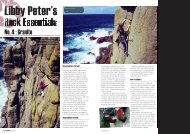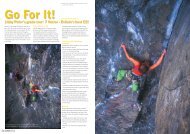You also want an ePaper? Increase the reach of your titles
YUMPU automatically turns print PDFs into web optimized ePapers that Google loves.
One Step in The Clouds (VS 4c) – perhaps<br />
these moves are where it got it’s name!<br />
Meillee Rafe tiptoeing her way delicately...<br />
...to be rewarded by a perfect incut fl ake!<br />
Other sections of dolerite cliff are blocky<br />
and the climbs weave their way cunningly<br />
beneath, between and even sometimes over<br />
the overhangs the blocks create. On these<br />
routes you need to expect the unexpected; be<br />
happy to make blind reaches and now and<br />
again pull hard.<br />
How to get gear in dolerite<br />
............................<br />
Once you get your eye in you find the most<br />
perfect nut placements in the world on<br />
dolerite; tapered rough cracks that were surely<br />
designed with this particular job in mind.<br />
Quite often the exact size isn’t crucial; you just<br />
aim vaguely for the right width and say ‘yeah<br />
that’ll do’ without having to fiddle away.<br />
Cams are also effective on this high<br />
friction rock, which has plenty of parallel<br />
sided cracks but don’t relax too much as<br />
there is also a tendency for the rock type to<br />
create shallow seams that defy all attempts<br />
to seat a nut in them.<br />
How is dolerite formed? ............................<br />
<strong>Dolerite</strong> is an igneous rock type, similar in<br />
origin to rhyolite but with a composition<br />
closer to basalt as it contains a higher<br />
proportion of iron and magnesium, giving it a<br />
darker colouring. It typically forms slabs and<br />
blocks and the varying crystal size and exact<br />
chemical make-up determines its roughness.<br />
<strong>Dolerite</strong> features and hazards<br />
............................<br />
The blocky nature of some dolerite cliffs is a<br />
worrying feature of its construction. Many of<br />
the blocks are inherently loose, even the big<br />
ones. It’s still possible, for example, to walk<br />
across the worn holds of the crux of a once<br />
popular VS called Fandango, which now lies<br />
on the approach path to Pant Ifan at<br />
Tremadog. Equally horrifying is the everwidening<br />
roof crack of Barbarian on the same<br />
crag. Always be mindful that some cliffs are<br />
inherently unstable.<br />
Trees provide quick and convenient belays<br />
but often cling to their rocky perches<br />
tenuously – treat them with love and respect<br />
or they won’t be there for much longer.<br />
A special mention goes to the translucent<br />
slugs at Tremadog after rain – I’m sure they<br />
have a proper name and important role to<br />
play in the ecology of the nature reserve<br />
but that doesn’t make them any more<br />
attractive when they’re occupying the same<br />
handhold as you.<br />
Wires don’t get much<br />
more ‘sinker’- than this!<br />
<strong>Libby</strong> has been climbing for over 20<br />
years, she is a qualified Mountaineering<br />
Instructor and British Mountain Guide and<br />
is the author of Rock Climbing – Essential<br />
Skills and Techniques published by MLTUK<br />
and recently produced Get Out On Rock –<br />
the definitive instructional DVD. Her base<br />
is <strong>No</strong>rthWales from where she runs the<br />
guiding outfit Llanberis Guides<br />
(info@llanberisguides.com).<br />
24 08|09<br />
climber.co.uk 08|09 25






